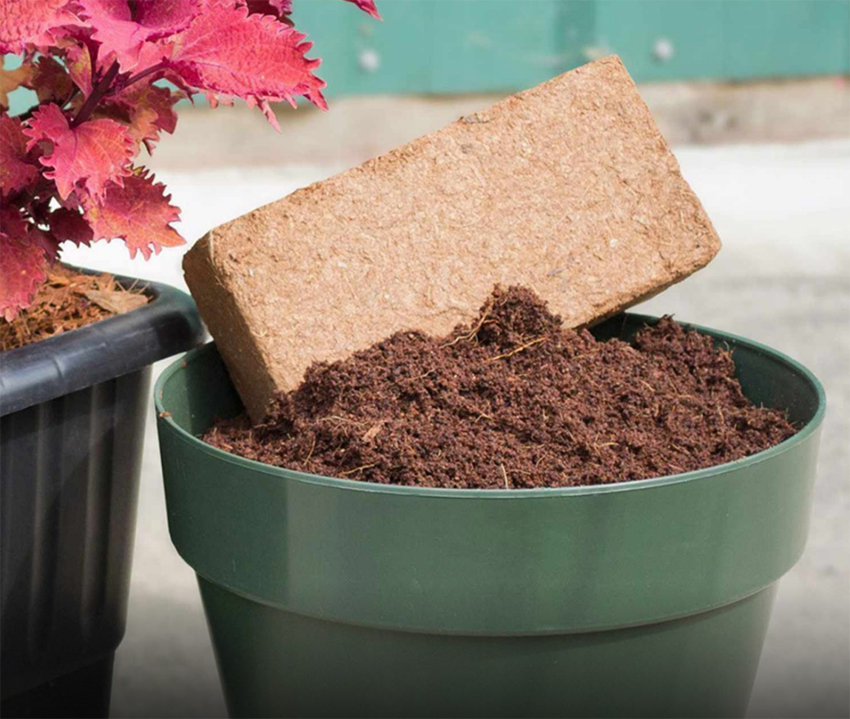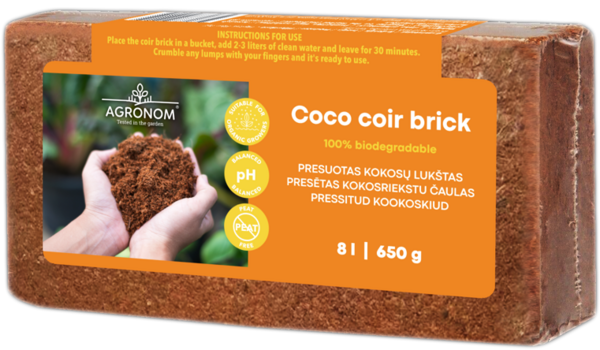(20cm x 10cm x 5cm).
Now you don’t have to carry heavy and bulky bags of soil or nutritious peat when you replant or plant a new plant.
650 g of this coconut soil, when adding water, takes up a volume of about 8.0 liters.
This soil perfectly absorbs and retains moisture, and also allows the roots to breathe freely.
Purpose: universal coconut substrate for planting and replanting flowers, indoor plants, bulbous flowers and sowing seeds.
Instructions for use: place a coconut briquette, fill with 2-3 liters of clean water and leave for 15-20 minutes at room temperature. Crush the lumps with your fingers, mix, add more water to the desired consistency and the substrate is ready for use. Stir again before use.
The finished substrate can be mixed in equal parts with garden soil and used for mulching plants and shrubs.

* COCONUT SUBSTRATE is a product of the coconut industry, which is the crushed remains of coconut peel.
The presence of a large amount of nutrients in the substrate is due to the fact that during the formation and growth of the coconut, a large amount of nutrients pass through its fibers, which subsequently remain in them. Coconut shavings have significantly better water absorption and retention properties than peat or other substrates.
Vegetable crops (tomatoes, cucumbers, peppers, eggplants and others) are usually grown on coconut substrate. Flower crops include seasonally flowering potted plants, cut crops (carnation, rose, gerbera, chrysanthemum, forcing bulbs, decorative foliage, ornamental trees and tubs crops Among berry crops, the most common is the cultivation of strawberries.
Coconut substrate, used once, can also be used for repeated crop rotations and for other plants, that is, it does not require disposal (like mineral wool, for example).
Coconut substrate is in good phytosanitary condition. As studies have shown, on average, per 100 microflora samples, coconut substrate contains 78% Penicillium, 10% Mucor, 8% Stysanus, 4% Aspergillis. In practice, coconut substrate does not contain pathogenic fungi.
Its main advantages are:
1. Organic and environmentally friendly material.
2. The pH of the substrate is optimal for the growth of most plants (ph 5.4 - 6.8).
3. Balance of all nutrients.
4. Excellent ability to mix with the ground.
5. Significant water holding capacity (retains 7 times its weight in moisture).
Coconut substrate absorbs water immediately and retains moisture much longer than peat.
Remains moist even after the soil itself has dried.
6. A structurally stable material that does not tend to break down in very humid environments.
7. Ensures rapid seed germination and accelerated plant growth.
8. Enables plants to create a more developed root system.
9. Long period of use (up to 5 years).
10. 100% absence of pathogenic fungi.
11. Does not promote the growth of bacteria and fungi.
11. Has no smell.
12. An excellent mulching material, and, moreover, when wet it has a pleasant dark color and a brighter texture than peat.
13. Self-decomposing material.
14. When compressed, it does not become compressed.
15. No pests.
* Coconut fiber is produced by processing the husks of coconut palms. It contains about 30% short fibers and 70% coconut dust. Long fibers are used to make mattresses, carpets, ropes, etc.
Due to the high lignin content in the soil, this unique structure is almost impossible to decompose. In addition, coconut fiber, unlike peat, does not “settle”, and its structure is not subject to change during mechanical processing (for example, during mixing).
Has the possibility of long-term and repeated use.












